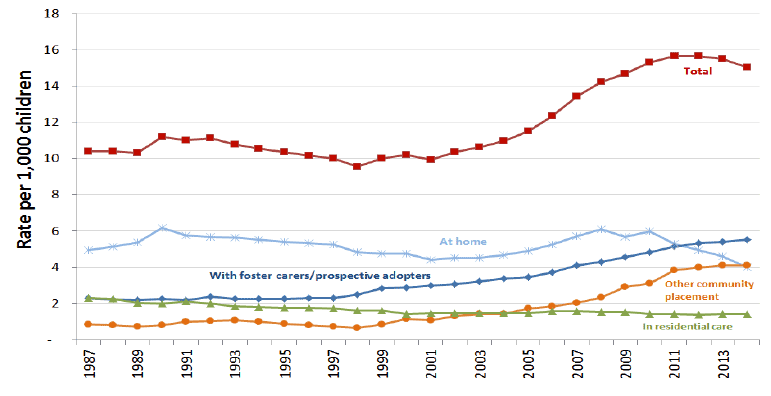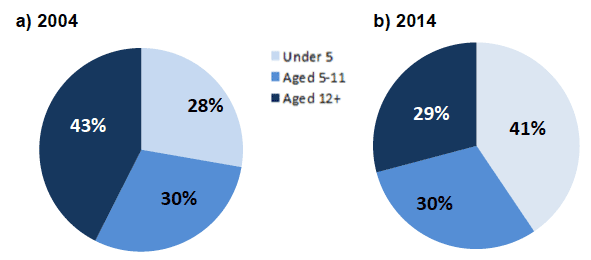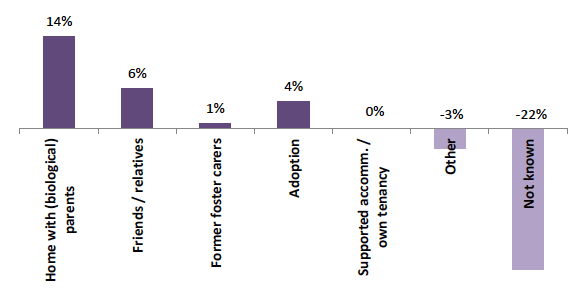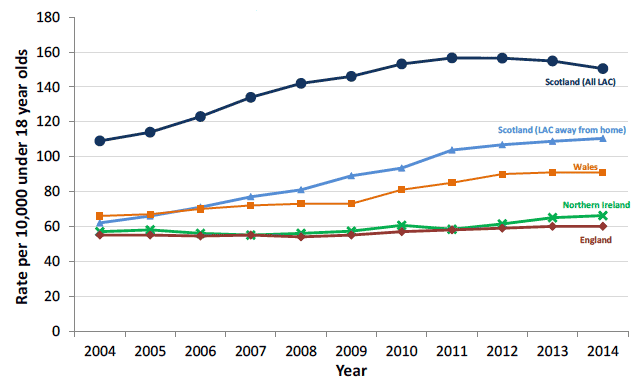Children's Social Work Statistics Scotland, 2013-14
statistics on child protection, looked after children and secure care accommodation
Children Looked After
 |
The total number of looked after children has fallen for the second year in a row |
 |
More children continue to be looked after in foster care than any other individual placement type |
 |
Children continue to start and cease to be looked after at younger ages |
This section presents data on children looked after during the period from 1 August 2013 to 31 July 2014. This will be referred to as 2014 for ease of reporting (with 2012-13 referred to as 2013 etc.). Local authorities have a responsibility to provide support to certain vulnerable young people, known as 'looked after children'. A young person may become looked after for a number of reasons, including neglect, abuse, complex disabilities which require specialist care, or involvement in the youth justice system.
At 31 July 2014, there were 15,580 looked after children - a decrease of 452 (or 3 per cent) from 2013. This is the second consecutive year the numbers have decreased following a peak of 16,248 in 2012, although this is still higher than any year in the last 30 years. The decrease in numbers of looked after children is due to a reduction in numbers of children starting to be looked after, which have also seen a decrease for the second year in a row.
There are several types of placements that looked after children or young people could be placed in, including at home (where a child is subject to a Supervision Requirement and continues to live in their normal place of residence), foster care, residential unit or school, a secure unit or a kinship placement (where they are placed with friends or relatives).
Chart 3: Children looked after per 1,000 children under 18 by type of accommodation, 1997-2014

Chart 3 shows there is a continued decreasing trend in children being looked after at home with this group accounting for only 27 per cent of the total in 2014 compared to 39 per cent in 2010. Conversely, more children are being looked after away from home in community settings, in particular with foster carers (36 per cent) and friends/relatives (27 per cent). 2014 was the third year running that there were more children looked after by foster carers/prospective adopters than looked after at home. Numbers of children looked after in residential care settings have been fairly static over recent years, but have seen a slight downward trend since 2007. Detailed information is shown in Table 1.1 below.
Table 1.1: Number of children looked after by type of accommodation, 2010-2014 (1)
| Type of Accommodation | 2010 | 2011 | 2012 | 2013 | 2014 |
|---|---|---|---|---|---|
| In the community:- | 14,412 | 14,770 | 14,815 | 14,566 | 14,110 |
| At home with parents | 6,193 | 5,476 | 5,153 | 4,762 | 4,144 |
| With friends/relatives | 3,172 | 3,910 | 4,076 | 4,183 | 4,181 |
| With Foster Carers provided by LA | 3,651 | 3,871 | 3,946 | 3,906 | 4,011 |
| With Foster Carers purchased by LA | 1,046 | 1,197 | 1,333 | 1,427 | 1,522 |
| With prospective adopters | 299 | 267 | 262 | 243 | 201 |
| In other community | 51 | 49 | 45 | 45 | 51 |
| Residential Accommodation:- | 1,480 | 1,461 | 1,433 | 1,466 | 1,470 |
| In local authority home | 620 | 615 | 564 | 575 | 580 |
| In voluntary home | 82 | 88 | 90 | 112 | 117 |
| In residential school | 471 | 460 | 451 | 439 | 393 |
| In secure accommodation | 82 | 86 | 95 | 65 | 82 |
| Crisis care | 17 | 13 | 14 | 12 | 16 |
| In other residential | 208 | 199 | 219 | 263 | 182 |
| Total looked after children | 15,892 | 16,231 | 16,248 | 16,032 | 15,580 |
(1) Figures are provisional and may be revised in 2014-15. Information on the number of children looked after by accommodation type is available back to 1971 in Table 1.1a of the excel version of the publication tables: http://www.gov.scot/Topics/Statistics/Browse/Children/PubChildrenSocialWork
When children become looked after, a care plan should be produced. The care plan should include detailed information about the child's care, education and health needs, as well as the responsibilities of the local authority, the parents and the child. A care plan is considered 'current' if it has been produced or reviewed in the past 12 months.
Table 1.2: Children looked after with and without a current care plan, at 31 July 2014 (1)
| Looked after at home | Looked after away from home | Total | |
|---|---|---|---|
| Number | |||
| With a current care plan | 4,129 | 11,264 | 15,393 |
| Without a current care plan | 15 | 172 | 187 |
| Total | 4,144 | 11,436 | 15,580 |
| Percentage | |||
| With a current care plan | 99.6 | 98.5 | 98.8 |
| Without a current care plan | 0.4 | 1.5 | 1.2 |
| Total | 100.0 | 100.0 | 100 |
(1) Figures are provisional and may be revised in 2014-15.
Table 1.2 shows that 99 per cent of the 15,580 children who were looked after at the end of July 2014 had a current care plan, a slight increase on 2013. There was little difference between children looked after at home and away from home - 99.6 per cent of those at home and 98.5 per cent of those away from home had a current care plan.
Children starting and ceasing to be looked after
The reduction in total numbers being looked after is reflected by decreases in the numbers of children starting and ceasing to be looked after. A child will be counted more than once in each set of figures if they have started being looked after and/or ceased being looked after more than once during the reporting year.
There were 4,292 children who started to be looked after during 1 August 2013 and 31 July 2014 - the lowest figure in the time series. Table 1.3 shows a four per cent decrease from 2013 (4,470) and a 17 per cent decrease from 2009 (5,201).
Table 1.3: Number of children starting to be looked after by age 2004, 2009, 2011-2014 (1)
| Year Ending 31 March | Year Ending 31 July | Percentage of totals(2) | |||||||
|---|---|---|---|---|---|---|---|---|---|
| 2004 | 2009 | 2011 | 2012 | 2013 | 2014 | 2004 | 2013 | 2014 | |
| Under 1 | 366 | 641 | 701 | 753 | 700 | 700 | 8 | 16 | 16 |
| 1-4 | 900 | 1,138 | 1,127 | 1,098 | 1,037 | 1,041 | 20 | 23 | 24 |
| 5-11 | 1,357 | 1,563 | 1,485 | 1,509 | 1,378 | 1,301 | 30 | 31 | 30 |
| 12-15 | 1,699 | 1,800 | 1,389 | 1,410 | 1,299 | 1,198 | 37 | 29 | 28 |
| 16-17 | 242 | 55 | 44 | 40 | 56 | 52 | 5 | 1 | 1 |
| 18-21(3) | - | 4 | 0 | 1 | 0 | 0 | - | 0 | 0 |
| Total | 4,564 | 5,201 | 4,746 | 4,811 | 4,470 | 4,292 | 100 | 100 | 100 |
(1) Table excludes planned series of short term placements. Figures for 2013-14 are provisional and may be revised. The number of looked after children aged 18+ was not asked for prior to 2006. A child may start to be looked after more than once in a year and so may be counted more than once.
Full data by gender and age group for 2000-2014 is available in Table 2.1 of the excel version of the publication tables http://www.gov.scot/Topics/Statistics/Browse/Children/PubChildrenSocialWork
(2) Due to rounding, the percentage totals may not equal the sum of their parts.
(3) The 18-21 category in this table may include a small number of looked after young people who were over 21 years.
Over the last 10 years children have started to be looked after at younger ages. In 2004, 28 per cent of children starting to be looked after were aged under five. By 2014 this had risen to 41 per cent, a two percentage point increase from last year. There was a corresponding decrease in the proportion of children aged 12+ being looked after (those aged 5-11 remained static) (Chart 4).
Chart 4: Percentage of children starting to be looked after by age

There were slightly more boys starting to be looked after in 2014 - 53 per cent compared to 47 per cent of girls; generally there is a fairly balanced gender split with children starting to be looked after.
Table 1.4 shows the number of children who ceased being looked after between 2004 and 2014. There were 4,676 children who ceased being looked after between 1 August 2013 and 31 July 2014, a decrease of one per cent from the 2013 figure (4,731) and an overall increase of 31 per cent since 2005, the year in which figures reached a low point of 3,566.
Table 1.4: Number of children ceasing to be looked after, by length of time looked after, 2004, 2009, 2012-2014(1),(2)
| Total | 2004 | 2009 | 2012 | 2013 | 2014 | 2004% | 2013% | 2014% |
|---|---|---|---|---|---|---|---|---|
| Under 6 weeks | 640 | 409 | 309 | 376 | 364 | 16 | 8 | 8 |
| 6 weeks to under 6 months | 583 | 333 | 407 | 407 | 397 | 14 | 9 | 8 |
| 6 months to under 1 year | 713 | 767 | 774 | 769 | 646 | 18 | 16 | 14 |
| 1 year to under 3 years | 1,317 | 1,718 | 1,850 | 1,760 | 1,736 | 33 | 37 | 37 |
| 3 years to under 5 years | 543 | 652 | 754 | 772 | 794 | 14 | 16 | 17 |
| 5 years and over | 225 | 515 | 674 | 647 | 739 | 6 | 14 | 16 |
| Total | 4,021 | 4,394 | 4,768 | 4,731 | 4,676 | 100 | 100 | 100 |
(1) Excludes children who are on a planned series of short term placements. Figures for 2013-14 are provisional and may be revised in 2014-15. If a child ceases to be looked after more than once during the year they will be counted more than once.
(2) Some totals do not exactly equal the sum of their component parts due to the effects of rounding.
The length of time children had been looked after at the point they stopped being looked after remained similar between 2013 and 2014, although the numbers of children looked after for more than three years has doubled since 2004.
Just as children are starting to be looked after at a younger age, children are also ceasing to be looked after at younger ages. The number of children ceasing to be looked after who were under the age of 12 increased by 43 per cent between 2004 and 2014. Fuller information can be found in the published Excel tables which accompany this release - see Annex B for details.
Upon leaving care, children are allocated to a destination category (Table 1.5). Around two-thirds of children (66.0 per cent in 2013-14) go home to their biological parents and 14.4 per cent go to live with friends or relatives. These categories, along with adoption have seen sizeable increases since 2007-08, however, as the number of 'not known' destinations has substantially decreased over the same period, it is difficult to draw any meaningful conclusions. Percentage differences between these years are shown in Chart 5 for reference.
Table 1.5: Percentage of children ceasing to be looked after by destination, 2008-2014(1),(2)
| Percentage of children ceasing to be looked after in year ending | |||||||
|---|---|---|---|---|---|---|---|
| 31 March | 31 July | ||||||
| Destination after leaving care | 2008 | 2009 | 2010 | 2011 | 2012 | 2013 | 2014 |
| Home with (biological) parents | 51.8 | 63.7 | 62.0 | 60.0 | 68.2 | 67.5 | 66.0 |
| Friends/relatives | 8.4 | 11.4 | 11.8 | 13.1 | 12.1 | 13.8 | 14.4 |
| Former foster carers | 1.0 | 1.6 | 1.9 | 1.2 | 1.3 | 1.3 | 1.7 |
| Adoption | 3.0 | 4.6 | 4.8 | 5.7 | 5.7 | 6.3 | 7.2 |
| Supported accommodation/own tenancy | 6.2 | 5.1 | 5.7 | 6.2 | 5.5 | 5.7 | 6.2 |
| Other(3) | 7.0 | 6.3 | 6.7 | 4.9 | 5.8 | 4.5 | 3.9 |
| Not known | 22.5 | 7.3 | 7.0 | 9.0 | 1.4 | 1.0 | 0.7 |
| 100.0 | 100.0 | 100.0 | 100.0 | 100.0 | 100.0 | 100.0 | |
(1) Table excludes planned series of short term placements. A child may cease to be looked after more than once during the year and will be counted once for each episode of care ending. Some totals do not exactly equal the sum of their component parts due to the effects of rounding.
(2) Figures for 2013-14 are provisional and may be revised in 2014-15.
Prior to 2008, table includes some estimates and some "not known"s where local authorities were not able to provide information.
(3) "Other" includes residential care, homeless, in custody and other destination.
Chart 5: Percentage difference by destination between 2008 and 2014

Local authorities are required to carry out a pathway assessment for aftercare services on young people who are over school leaving age but are still looked after within three months of the young person becoming compulsorily supported. These young people should be provided with a pathway co-ordinator who assesses their needs and a pathway plan which outlines how the local authority plans to meet the needs of the young person.
Of those young people who had reached their minimum school leaving age at the time they ceased to be looked after during 1 August 2013 to 31 July 2014, 80 per cent had a pathway plan and 77 per cent had a pathway co‑ordinator. Where a young person's final placement type was 'at home' they were less likely to have a pathway plan or a pathway co-ordinator than if the final placement type was 'away from home'. Table 1.6 shows that, of children whose last placement was at home, 70 per cent had a pathway plan and 65 per cent a pathway coordinator, compared with 87 and 86 per cent (respectively) of those whose final placement type was 'away from home'.
Table 1.6: Pathway plans and nominated pathway co-ordinators of young people who were beyond minimum school-leaving age on the date they ceased to be looked after during 2013-14(1)
| Looked after at home | Looked after away from home | Total | |
|---|---|---|---|
| Number | |||
| With a pathway plan | 383 | 636 | 1,019 |
| Without a pathway plan | 164 | 95 | 259 |
| With a nominated pathway co-ordinator | 358 | 630 | 988 |
| Without a nominated pathway co-ordinator | 189 | 101 | 290 |
| Total | 547 | 731 | 1,278 |
| Percentage | |||
| With a pathway plan | 70 | 87 | 80 |
| Without a pathway plan | 30 | 13 | 20 |
| With a nominated pathway co-ordinator | 65 | 86 | 77 |
| Without a nominated pathway co-ordinator | 35 | 14 | 23 |
| Total | 100 | 100 | 100 |
(1) Figures are provisional and may be revised in 2014-15. Figures include all episodes of ceasing to be looked after beyond minimum school leaving age (i.e. a child may be counted more than once).
Aftercare services
Local authorities have a duty to provide advice, guidance and assistance for young people who - at the point they leave care - have reached minimum school leaving age, referred to as 'aftercare services'. Table 1.7 shows the number of young people eligible for aftercare services on 31 July 2014 by age and their economic activity. 'Economic activity' refers to whether a young person was in education, employment or training.
There were 3,767 young people reported to be eligible for aftercare services on 31 July 2014, of whom 70 per cent were receiving aftercare, broadly similar to 2013. Forty-six per cent of those receiving aftercare and who had a known economic activity were in education, training or employment. This is a three percentage point increase on 2013, although direct comparisons should be treated with caution as numbers are susceptible to fluctuation.
For young people receiving aftercare with known education/employment status, there is little variation by age with those aged 15-17 only slightly more likely to be in education, training or employment than those aged 18-21.
Table 1.7: Young people eligible for aftercare services by age and economic activity, at 31 July 2014 (1)(2)
| % of young people | |||||||
|---|---|---|---|---|---|---|---|
| Age | Total | eligible for aftercare | receiving aftercare with known economic activity | ||||
| Economic activity on 31 July 2014 | 15-16 | 17 | 18 | 19-21(3) | |||
| In education, training or employment | |||||||
| 94 | 220 | 249 | 437 | 1,000 | |||
| In higher education | 12 | 29 | 49 | 66 | 156 | 4 | 7 |
| In education other than HE | 41 | 88 | 74 | 131 | 334 | 9 | 15 |
| In training or employment | 41 | 103 | 126 | 240 | 510 | 14 | 23 |
| Not in education, training or employment | |||||||
| 95 | 229 | 307 | 541 | 1,172 | |||
| - due to short term illness | * | * | 15 | 12 | 32 | 1 | 1 |
| - due to long term illness or disability | * | * | 15 | 37 | 57 | 2 | 3 |
| - due to looking after family | 9 | 12 | 19 | 54 | 94 | 2 | 4 |
| - due to other circumstances | 84 | 209 | 258 | 438 | 989 | 26 | 46 |
| Not known | 58 | 96 | 115 | 187 | 456 | 12 | |
| Not receiving aftercare | 153 | 265 | 398 | 323 | 1,139 | 30 | |
| Total | 400 | 810 | 1,069 | 1,488 | 3,767 | 100 | |
| Percentage in employment, education or training | |||||||
| As percentage of all young people eligible for aftercare ("Total") | 24 | 27 | 23 | 29 | 27 | ||
| As percentage of young people receiving aftercare with known economic activity ("Total" excluding "Not Known" and "Not receiving aftercare) | 50 | 49 | 45 | 45 | 46 | ||
(1) Figures are provisional and may be revised in 2014-15.
(2) Cells containing * represent numbers that are suppressed to maintain confidentiality. Due to rounding, the totals for percentages may not equal the sum of their parts.
(3) The 19-21 category in this table includes a small number of young people over the age of 21 who were receiving aftercare.
Short-term placements
Until 2012-13, data was collected on planned short-term placements, where a child, for the purposes of respite, stays away from home for more than 24 hours continuously. The statistics ceased to be collected in 2013-14.
At 31 July 2013, the last date for which data is held, there were 1,914 children being looked after on a planned series of short-term placements. Sixty-one per cent of these children were looked after in residential establishments, whilst 25 per cent were looked after in foster placements. More details are available in previous years' publications.
Cross-UK looked after comparisons
The definition of "looked after children" varies across the countries within the UK. In Scotland children looked after at home are included in the definition and in the statistics whereas, they are usually excluded in the England and Wales statistics. As a result, it is not meaningful to simply compare rates in Scotland with the rest of the UK. The published Scottish figure is at 31 July 2014 where other UK nations are at 31 March. To improve comparability, the Scotland figure at 31 March has been used in the comparison chart below.
Chart 6 gives Scottish figures both including and excluding children looked after at home. This shows that, even when children looked after at home are excluded, in the last three years, the rate is still increasing more quickly than in England and Wales, but more slowly than in Northern Ireland. The rates in Wales and England have barely increased in the last two years, although Wales is noticeably higher than in 2009. This sharp increase in numbers in Scotland over the past 10 years, coincides with a focus on intervening earlier in the lives of vulnerable children and may explain the higher rate in Scotland. This is reflected in the data which shows looked after children tend to be younger in Scotland than the rest of the UK - 12 per cent of looked after children in Scotland are aged 16 or over, compared to 21 per cent in England (19 per cent in Northern Ireland and 17 per cent in Wales).
Chart 6: Cross-UK comparison of rate of looked after children per 10,000 children, 2004-2014

Links to the cross-UK data underlying Chart 6 can be found in Background Note 1.7. There is more information on the comparability of looked after children data across the UK: http://www.gov.scot/Topics/Statistics/Browse/Children/socialservicestats
There are additional tables on looked after children available at: http://www.gov.scot/Topics/Statistics/Browse/Children/PubChildrenSocialWork
Contact
Email: Ian Volante
There is a problem
Thanks for your feedback